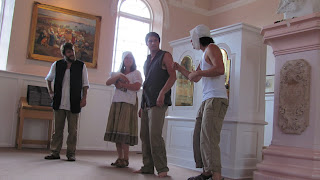At Grand Pre', the original site of the Cajun settlement, the culture thrived for many years. The Cajuns were originally French citizens that resettled in Nova Scotia. The Cajuns thrived my learning how to dike off land that was covered by water during the huge tidal changes of the Bay of Fundy. The dikes would block the salt water tides from flooding the land. Ingenuous check valves were developed by the Cajuns to keep the salt water out but allowed rain water to drain. After three years the salt in the soil would evaporate and the Cajuns would plant crops in this fertile land. They thrived and prospered.
The British and the French were constantly battling over ownership of various parts of Nova Scotia. The Cajuns would not swear allegiance to the British or the French. Finally, the British invaded the Cajuns and sent them to all parts of the world. Some of the Cajuns ended up in Louisiana, which was French land at the time. Through the years the Cajuns learned to manage the land in Louisiana and began farming again.
We toured the original church on the Grand Pre' property. The Canadian National Parks manage the property. A group of young people acting as residents of the time would give groups tours of the property and answered any questions.
My family ties are within this group of Cajuns that was expelled from Acadia, Nova Scotia, or Grand Pre'.
As we toured the property, we looked into one of the workshops. The workshop below was a blacksmith shop. It was amazing how these hardy people thrived in such harsh land.
Even today, plants were green and thriving. The entire area is laid out in farms. We passed many tractors and combines as we traveled the roads in these farm areas.
We also visited Port Royal. This is the location of Annapolis Royal, the site of Nova Scotia's first tidal power generating plant. Simply, the facility uses the tidal movements of the Bay of Fundy to generate electricity. Power is generated by impounding water and allowing the water to flow out into the lower tide level. We toured the facility, but unfortunately, pictures were not allowed.
 |
| Picture of me standing at the entrance to Port Royal. Notice the "Moose" around my neck. It is a long story, but it is part of the Tracks experience. |
 |
| The Canadian National Parks do a great job with their parks. Here an interpreter, dressed in clothing of the period, chats with me. |
 |
| I found this nice restored military jeep parked in a coastal fishing village. |
 |
| As you can see by the sticker on the rear of the jeep, not all Canadian citizens are satisfied with "the system". |







No comments:
Post a Comment
Please leave your comments....